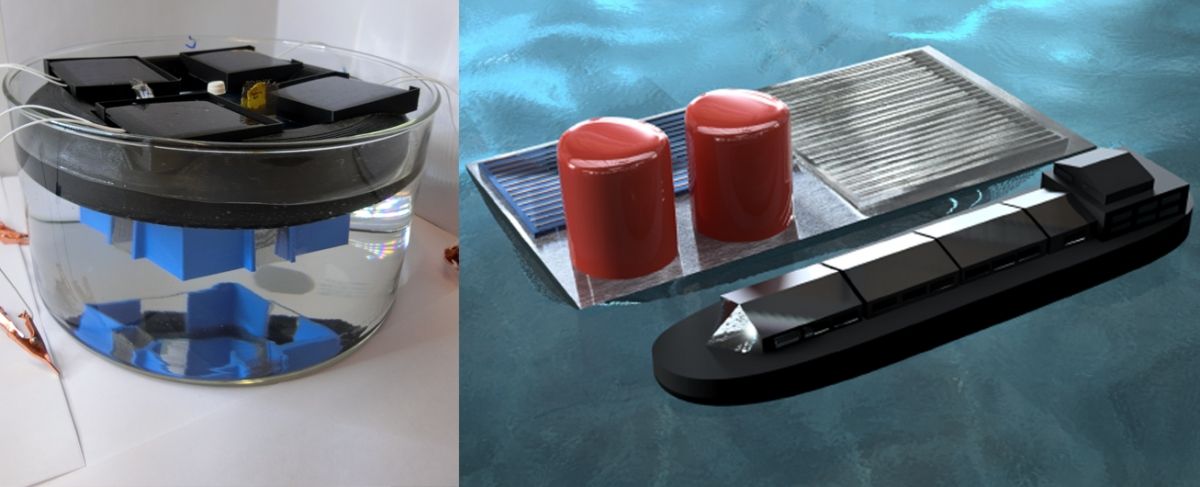
Imagine if the deep sea oil rigs—like those responsible for the 2010 Gulf oil spill—were replaced with floating solar cells. Scientists have now developed a prototype of such a device—dubbed a solar fuels rig—that uses sunlight and water to create fuel.

Hydrogen fuel, which these cells make, is often produced from natural gas, and it releases carbon dioxide—the key greenhouse gas that is causing climate change. Hydrogen fuel is currently used to propel rockets in NASA's space program and could play a role in a sustainable future. This device built by Columbia University researchers could create it without the damaging greenhouse gas emissions and without taking up land space or using freshwater as well.
This design has the potential to be low cost and have high durability, said Daniel Esposito, senior author and chemical engineering professor at Columbia.
"We believe that our prototype is the first demonstration of a practical membraneless floating [photovoltaic-electrolyzer] system, and could inspire large-scale 'solar fuel rigs' that could generate large quantities of [hydrogen fuel] from abundant sunlight and seawater without taking up any space on land or competing with fresh water for agricultural uses," Esposito said in a statement.
Electricity generated from sunlight, hence the solar cells, tips off the process of electrolysis, which then separates hydrogen and oxygen from each other in water molecules. The oxygen is released into the atmosphere while hydrogen is captured for creating fuel.
The findings of the new lab-built system, technically called a photovoltaic-powered electrolysis device, were published Friday in the International Journal of Hydrogen Energy. Current methods of electrolysis require expensive membranes to separate the gases, which are essentially dividers that separate the hydrogen and oxygen when they are split apart. But in salt water, the dividers are vulnerable to quick degradation. This new method uses the buoyancy of the bubbles in the water to help the two gases—hydrogen and oxygen—be separated and collected.

"Being able to safely demonstrate a device that can perform electrolysis without a membrane brings us another step closer to making seawater electrolysis possible," Jack Davis, lead author and researcher at Columbia, said in a statement. "These solar fuels generators are essentially artificial photosynthesis systems, doing the same thing that plants do with photosynthesis, so our device may open up all kinds of opportunities to generate clean, renewable energy."
The researches also installed high-speed videos on the device, which took 500 frames per second, to monitor the point in the process called "crossover." This is the period in which the hydrogen and oxygen bubbles could crossover into each the other's lane, so to speak—which harms product purity, could lead to safety concerns, and make the process more expensive. This device produced hydrogen with 99 percent purity.
One big challenge for this technology is how to make it scalable and economically viable to convert sunlight into energy and store it for later, according to Esposito.
"The floating device we demonstrated in our lab is just a single unit that is about six inches in diameter," Esposito told Newsweek by email. "For a commercial application, we envision that the size of this unit would need to increase, and hundreds to thousands of units would be connected in a modular system in order to generate the desired amount of [hydrogen fuel]."
Further research on developing catalyst materials that work better in seawater is one of the next steps. Chlorine gas can also be produced from seawater electrolysis, and though it has economic value, it is also toxic.
"There are many possible technological solutions to achieve a sustainable energy future, but nobody knows exactly what specific technology or combination of technologies will be the best to pursue," Esposito said. "We are especially excited about the potential of solar fuels technologies because of the tremendous amount of solar energy that is available."
Uncommon Knowledge
Newsweek is committed to challenging conventional wisdom and finding connections in the search for common ground.
Newsweek is committed to challenging conventional wisdom and finding connections in the search for common ground.
About the writer
Sydney Pereira is a science writer, focusing on the environment and climate. You can reach her at s.pereira@newsweekgroup.com.
To read how Newsweek uses AI as a newsroom tool, Click here.








